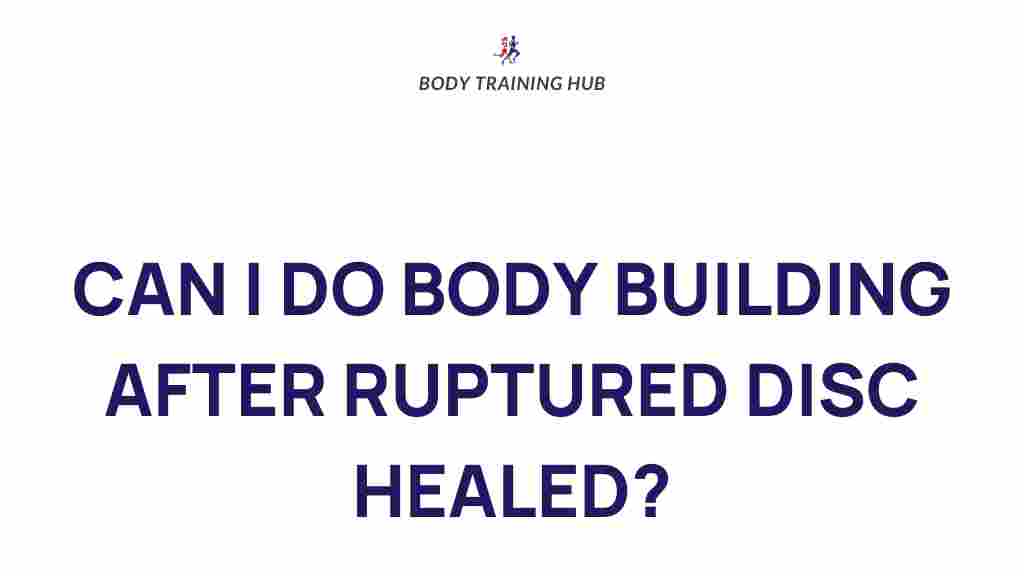Unleash Your Potential: Bodybuilding After Recovering from a Ruptured Disc
Experiencing a ruptured disc can be a life-altering event, especially for those passionate about bodybuilding and strength training. The journey to recovery may seem daunting, but with the right approach, it can also be an opportunity to build resilience and enhance your fitness journey. In this article, we’ll explore effective strategies for bodybuilding after recovering from a ruptured disc, focusing on injury rehabilitation and strength training.
Understanding the Ruptured Disc
A ruptured disc, also known as a herniated disc, occurs when the soft cushion between the vertebrae in your spine pushes out, potentially pressing on nearby nerves. This condition can lead to severe pain, numbness, and weakness, often making it difficult to engage in physical activities, including bodybuilding.
The Importance of Recovery
Before diving back into bodybuilding, it’s crucial to prioritize recovery. Recovery not only relieves pain but also strengthens the surrounding muscles and improves flexibility, which is vital for safe strength training. The recovery process can be broken down into several key phases:
- Initial Rest: Allow yourself time to heal. Rest is essential during the first few weeks.
- Physical Therapy: Consult with a physical therapist to develop a rehabilitation plan tailored to your needs.
- Gradual Return to Activity: Slowly reintroduce low-impact activities before progressing to bodybuilding.
Step-by-Step Process: Bodybuilding After Recovery
Once you have consulted your healthcare provider and completed the initial recovery phases, you can begin your bodybuilding journey with care. Follow these steps to ensure a safe transition back into strength training:
1. Consult with Professionals
Before starting any fitness program post-recovery, consult with healthcare professionals such as your physician or a physical therapist. They can provide personalized advice based on your recovery progress and help you design a suitable bodybuilding routine.
2. Start with Core Strengthening
Strengthening your core is vital after a ruptured disc, as a strong core supports your spine and helps prevent future injuries. Incorporate these core exercises:
- Pelvic Tilts: Gentle movements that engage your lower back and abdominal muscles.
- Bridges: Strengthens the glutes and lower back.
- Bird-Dogs: Improves balance and core stability.
3. Focus on Flexibility and Mobility
Incorporate stretching and mobility exercises to enhance your range of motion. Yoga and Pilates can be excellent options to improve flexibility while being gentle on your spine.
4. Gradually Introduce Resistance Training
Once you feel comfortable with core exercises and flexibility training, you can start incorporating resistance training. However, it’s essential to:
- Use light weights to avoid strain.
- Focus on proper form to prevent re-injury.
- Incorporate machines instead of free weights initially for added support.
5. Incorporate Bodyweight Exercises
Bodyweight exercises can be a great way to build strength without putting too much pressure on your back. Consider these exercises:
- Push-Ups: Works the chest and arms.
- Squats: Strengthens the lower body while keeping the core engaged.
- Modified Planks: Focus on building core strength without excessive strain.
6. Monitor Your Body’s Response
Listen to your body throughout your fitness journey. If you experience discomfort or pain, stop the exercise and consult a professional. It’s essential to differentiate between muscle fatigue and pain that could signal a problem.
7. Gradually Increase Intensity
As your strength and confidence grow, gradually increase the intensity of your workouts. Add more weight, increase repetitions, or incorporate more challenging exercises, always prioritizing safety and proper technique.
8. Incorporate Cardiovascular Training
Cardiovascular exercise is essential for overall health and can aid in your recovery. Activities like walking, swimming, or cycling can improve your fitness level without putting undue stress on your back.
9. Nutrition Matters
A well-balanced diet supports your recovery and bodybuilding efforts. Focus on:
- Protein: Essential for muscle repair and growth.
- Healthy Fats: Supports overall health and reduces inflammation.
- Fruits and Vegetables: Packed with vitamins and minerals to aid recovery.
10. Stay Consistent and Patient
Consistency is key in any fitness journey. Set realistic goals and be patient with your progress. Celebrate small achievements along the way, and remember that recovery is a gradual process.
Troubleshooting Tips for Common Challenges
Even with a solid plan in place, you may encounter challenges during your bodybuilding journey after a ruptured disc. Here are some common issues and how to address them:
1. Pain During Exercise
If you experience pain during your workouts, it’s crucial to:
- Stop the exercise immediately.
- Consult your healthcare provider for advice.
- Consider modifying your routine, focusing on lower-impact exercises.
2. Lack of Motivation
Staying motivated can be tough post-injury. To reignite your passion for bodybuilding:
- Set specific, achievable goals.
- Join a supportive fitness community or find a workout buddy.
- Keep a journal to track your progress and celebrate small victories.
3. Fear of Re-Injury
It’s natural to feel apprehensive about re-injury. To build confidence:
- Start slow and gradually increase the intensity.
- Focus on proper form and technique.
- Seek guidance from a trainer experienced in injury rehabilitation.
Conclusion
Embarking on a bodybuilding journey after recovering from a ruptured disc is a testament to your strength and resilience. With a focus on injury rehabilitation, proper recovery, and thoughtful progression in strength training, you can safely return to the gym and unleash your full potential. Remember, every fitness journey is unique, so take your time, listen to your body, and enjoy the process of becoming stronger than ever.
For additional resources on injury rehabilitation and fitness, check out this comprehensive guide. Always prioritize safety and consult with professionals as you navigate your recovery journey.
As you embark on this new phase in your fitness journey, stay inspired and motivated. Your commitment to bodybuilding after a ruptured disc can pave the way for a healthier, stronger future.
This article is in the category Strength & Recovery and created by BodyTraining Team
